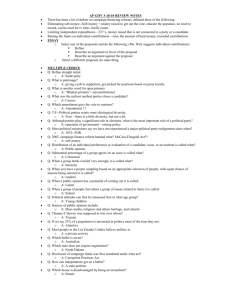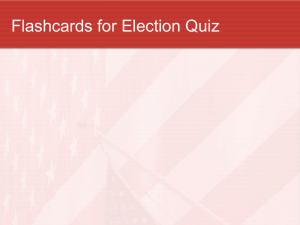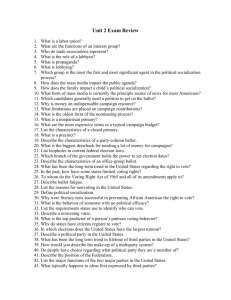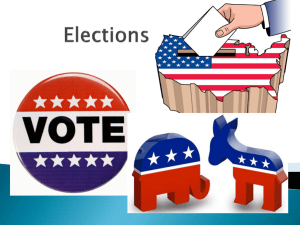Chapter_8
advertisement
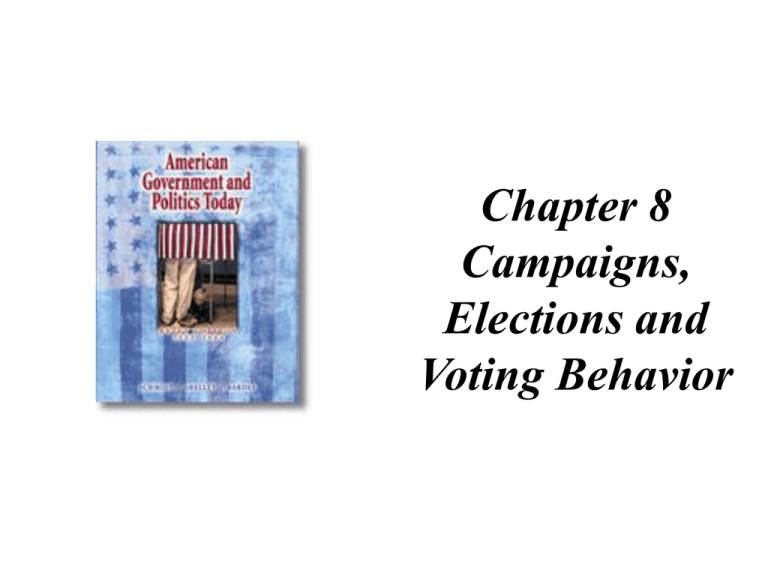
Chapter 8 Campaigns, Elections and Voting Behavior Who Is Eligible to Run for Office • there are few eligibility requirements to run for most U.S. offices • President •must be a natural born citizen •must be 35 years old •must be a resident of the country for 14 years before inauguration • Vice President •must be a natural born citizen •must be 35 years old • must not be a resident of the same state as the presidential candidate • Senate •must be a citizen for at least nine years •must be 30 years old •must be a resident of the state from which elected • Representative •must be a citizen for at least seven years •must be 25 years old •must be a resident of the state from which elected The Modern Campaign Machine • longer campaigns than in past times • greater emphasis on funds • lesser emphasis on political parties • greater reliance on political consultants, who are hired to devise a campaign strategy • greater emphasis on candidate visibility, or name recognition • greater use of polls and focus groups •tracking polls -- indicate how well a campaign is going by polling nearly every day •focus groups -- are small groups of people consultants use to gather information about reactions to candidates and issues Regulating Campaign Finance • Federal Corrupt Practices Act of 1925 •limited election expenses for candidates •required disclosures •was ineffective because of its many loopholes • The Hatch Act of 1939 •prohibited groups from spending more than $3 million in a campaign •limited individual contributions to committees to $5,000 •designed to end influence peddling • Federal Election Campaign Act (FECA) of 1972 •restricted mass media expenditures •limited contributions by candidate and family members •required disclosure of all contributions over $80 •provided $1 voluntary check-off for presidential campaigns on federal income tax form Regulating Campaign Finance (cont.) • Amendments to the Federal Election Campaign Act of 1974 •created the Federal Election Commission •provided public financing of presidential elections’ •limited presidential election campaign spending •limited contributions •required disclosure of contributions and expenditures •allowed corporations, unions and special interest to establish political action committees (1976 amendment) • Buckley v. Valeo (1976) declared the 1972 limitation on what an individual could spend on his or her own election unconstitutional Beyond Campaign Finance Law Soft Money: contributions to parties that escape the limits of federal election law • Soft money – the Supreme Court said that “party building activities” (like voter registration drives and education) should be encouraged, thus allowing unlimited and unregulated contributions to political parties • Independent (issue advocacy) expenditures – are non-regulated funds spent by individuals or interest groups on advertising or other campaign activities that are not coordinated with any candidate’s expenditures • Bipartisan Campaign Reform Act of 2002 - increases the limit on individual contributions to federal candidates from $1,000 to $2,000 and increases amount one can give to all federal candidates in a two-year period from $25,000 to $95,000 • Bundling – is the practice of adding together maximum individual contributions and presenting them to the candidate together to maximize their impact What is a Presidential Primary? • a statewide primary election of delegates to a party’s national convention to help a party determine its presidential nominee • The purpose was to open the nomination process to ordinary party members and to weaken the power of party bosses • Until 1968 there were few primaries. Most were just “Beauty Contests” that didn’t factor into the convention nomination process • National Conventions were a gathering of the party elite where deals were made between candidates and delegates were informed who to vote for • McGovern-Fraser Commission changed the way nominations work Types of Presidential Primaries • closed primary – only voters who are declared party members can vote in that party’s primary • open primary – voters can vote in either party primary without disclosing their party affiliation. Must choose one party, though. • blanket primary – voters can vote in primary elections for candidates of more than one party (a Democrat for the presidential nominee and a Republican for the Senate nominee, for example) • run-off primary – if no candidate receives a majority in the first primary, some states require a second primary between the top two candidates The Electoral College • Electors in the Electoral College actually elect the president and vice president of the United States (538 electors) • the numbers of electors in each state is equal to that state’s number of representatives in both houses of Congress, CA = 55 • electors typically cast their votes for the candidate that receives the plurality of votes in that state. (not what framers envisioned) •The first Monday after the second Tuesday in Dec. •Ballots are counted and certified by Congress in Jan. • because of the winner-take-all system of the electoral college, it typically serves to exaggerate the popular margin of victory Why Don’t People Vote? • political withdrawal – fewer citizens feel involved enough in their community to be interested in voting • rational ignorance – people choose not to inform themselves on issues because they do not believe their vote is likely to be a deciding factor • campaign effects – the length of campaigns and negative advertising may drive voters away How elections are conducted • • • • • • Australian ballot Office-block ballot Party-column ballot Coattail effect Mail ballots Vote fraud Voting • Low voter turnout (apathy or satisfaction?) • Legal restrictions on voting – Citizen, age, and residency • How do voters decide? – Socioeconomic factors (next slide) – Psychological factors • Party identification, perception of candidates (emotions), Issue preferences (economy, foreign policy) • Are issues more important than image and party loyalty? Factors that Influence Who Votes • age: The older you are the more you vote • educational attainment: The more education the more you vote • minority status: Whites vote more, but blacks are close • geographic location: Dems. North, East cities, GOP rural except South • income levels: The wealthier you are the more you vote • two-party competition: States with higher competition in an election get more people to turn out to vote Factors that Influence How People Vote • • • • • • • Education: More Education – Republican; Less Education - Democrat Income and socioeconomic status: Higher – Rep.; Lower – Demos. Religion: Protestants – Rep.; Catholics/Jews – Demos. Ethnic background: Northern Europeans – Rep.; Others – Demos. Gender: The “Gender Gap” varies from election to election Age: Older – Rep.; Younger – Demos. Geographic region: Coastal – Demos.; Inland – Rep. • Psychological factors •party identification: The most important determinant in voting behavior in national elections. This is caused by political socialization •perception of the candidates: Based on emotions rather than experience •issue preferences: “issue voting” it is difficult to determine how issues overshadow party loyalty or candidate personality in voters •Issues could be economic, foreign, or social Hot Links to Selected Internet Resources: • http://www.wadsworth.com/cgiwadsworth/course_products_wp.pl?fid=M2&discipline_number=20& product_isbn_issn=0534592651 • http://www.wadsworth.com/politicalscience • http://www.fec.gov • http://www.opensecrets.org •

